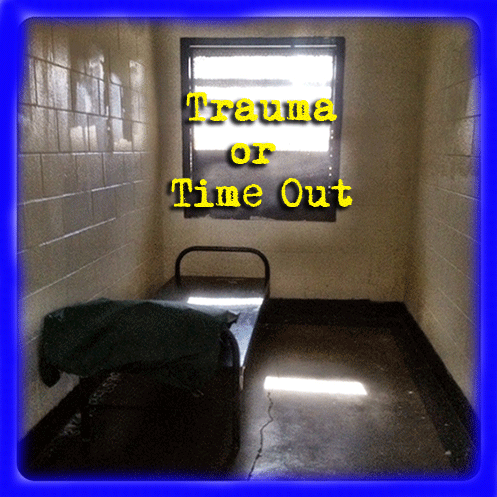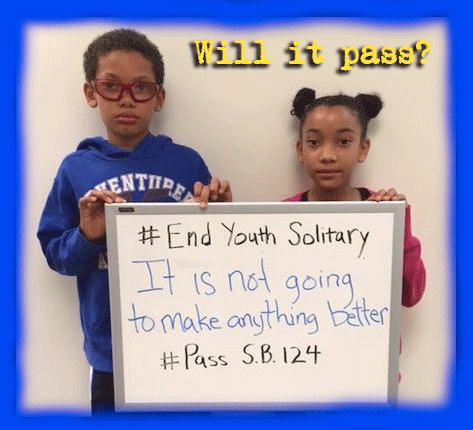EDITOR’S NOTE: On Tuesday, California took a large step closer to banning the use of solitary confinement for the state’s youth when SB 124 passed out of the assembly’s Public Safety committee. The bill needs to pass through one more committee* before it can be up for a vote in the assembly itself. (Th Public Safety committee vote divided along party lines with five democrats voting “yes,” two republicans voting “no.”)
The bill has already been passed by the state senate. So if it is passed by the assembly it goes to Governor Brown for his signature.
An impressive list of supporters, including the LA County Board of Supervisors, have gotten behind the passage of SB 124. Yet the bill also has its strong opponents.
As a consequence, the conversation about the use of solitary confinement for juveniles is bound to heat up as the crucial assembly vote nears. With this in mind, in her excellent story below reporter Kelly Davis digs deeply into what we know and don’t know about the issue of kids and solitary.
This story first ran in an earlier version at The Crime Report— where you can find the latest in national criminal justice news daily.
LOCKED UP & ALONE
What Do We Really Know About Solitary for Kids?
by Kelly Davis
How do you define solitary confinement? That question is at the core of a California debate over ending the practice in state- and county-run juvenile detention facilities, which are estimated to house roughly 9,000 individuals at any given time.
The debate intensified earlier this year with the introduction of a bill sponsored by state Sen. Mark Leno (D-San Francisco), which would ban the use of solitary confinement as punishment. Under the bill, young people who pose a safety risk can be confined to their rooms—but for no longer than four hours.
Despite three previous attempts to pass similar legislation, Leno believes the bill will succeed, given the increased scrutiny nationwide on the use of solitary confinement.
In May, Illinois became the 20th state to ban the practice in juvenile detention facilities.
“I don’t believe there’s any data that even begins to suggest that there is anything beneficial to this practice,” Leno said in an interview with The Crime Report. “The idea that taking a troubled youth with behavioral problems and putting that youth in solitary confinement—whether for 10 hours or 23 hours—and thinking the behavior is going to improve, is completely irrational.”
The Leno bill defines solitary confinement as “the placement of an incarcerated person in a locked sleep room or cell alone with minimal or no contact with persons other than guards, correctional facility staff, and attorneys.
The state’s influential prison-guard and probation unions have opposed the bill—-and its predecessors—arguing that solitary confinement is an inaccurate description of current practice in juvenile facilities. They say that isolation of juveniles is used sparingly, and is regulated by California’s Minimum Standards for Juvenile Facilities, which were recently revised to urge limited use of room confinement.
Nevertheless, youth advocates—who want to see a ban enshrined in state law—-point to recent examples that they claim could not be described otherwise than “solitary confinement.”
A GAME CHANGER IN CONTRA COSTA
Last month, Contra Costa County, located just east of San Francisco, agreed to settle a lawsuit brought by two public-interest law firms, Disability Rights Advocates and Public Counsel. The lawsuit claimed young people with psychiatric and developmental disabilities were being kept in 12-by-12-foot cells for up to 23 hours a day in the country’s juvenile hall.
Although Contra Costa County’s Office of Education and its Probation Department denied any wrongdoing, the county committed itself under the settlement to ensure that the maximum period of confinement for any youth will be four hours, and only if he is considered a danger to others—which in fact mirrors the language of the Leno bill.
Leno described the Contra Costa settlement as a “game-changer” when it comes to enacting a statewide ban on punitive solitary confinement.
In another case, the Youth Law Center, a San Francisco-based national advocacy group,– has filed a complaint against San Diego County with the Department of Justice, based on an investigation launched in 2013 into reports of excessive use of pepper spray in the county’s juvenile detention facilities. In the course of that investigation, attorneys found examples of young people, some of them suicidal, being confined to their rooms for up to five days—-despite county inspection reports saying that room confinement was never used.
A spokesperson for San Diego County declined to comment—-citing “pending legal action”—–on whether YLC’s complaint prompted any policy changes.
A DISCIPLINARY TOOL OR A SOURCE OF TRAUMA?
Amid the growing national debate over ending youth solitary confinement, California is an example of the disconnect between law enforcement authorities who cling to isolation as a disciplinary tool and experts who say confinement beyond a few hours can cripple a young person’s development.
“Even short term, especially if a young person has an underlying mental health issue, that creates serious consequences,” Jennifer Kim, director of programs for the San Francisco-based Ella Baker Center for Human Rights, a supporter of Leno’s bill, said in an interview with The Crime Report.
“The impact that has on that person’s emotional and physical well-being is going to be exacerbated, whether it’s 72 hours or two months.”
Further obscuring the issue, advocates say, are the variety of terms for the practice. Before a Justice Department investigation shuttered Mississippi’s Columbia Training School, for instance, young female detainees were confined to dark, bare rooms in what was called the “Special Intervention Unit.”
“People call it all sorts of things inside juvenile facilities,” says Dana Shoenberg, deputy director of the Washington D.C.-based Center for Children’s Law and Policy.
“They call it reflection time, they call it segregation, they call it medical isolation. But if you lock a kid alone in a room for a sustained period of time, the effects are still the same.”
While a locked room in a San Diego County facility might be a far cry from something like the Columbia Training School, the effects of isolation in either setting, experts say, can undermine rehabilitation and exacerbate mental illness. A 2009 national study commissioned by the Justice Department found that of the 79 detainees who committed suicide in juvenile detention centers between 1995 and 1999, nearly two-thirds had a history of room confinement.
Roughly half committed suicide while in isolation.
In a report last year, the American Civil Liberties Union concluded it was nearly impossible to pin down how many young people are subjected to isolation, why and for how long, since data collection is not required on the state or federal level.
Kim said the semantics of solitary confinement has made it difficult to really measure the scope of the problem in California.
“If you have different counties and the state using different names to refer to the same practice, it provides a way for people to create confusion around how much something is happening,” she said.
“One of the issues this bill is trying to correct is the fact that this practice is happening with very little accountability and very little transparency,” she added.
DATA MATTERS
Getting accurate data is a key hurdle.
“A lot of it is just not being able to objectively see that what you’re doing falls in that definition of solitary confinement,” says Sue Burrell, a staff attorney for the Youth Law Center, a national advocacy group. “For so long, everyone in juvenile justice has dealt with disciplinary problems by locking kids in their rooms.”
Punitive isolation is frowned upon by the Juvenile Detention Alternatives Initiative, a project of the Annie E. Casey Foundation that seeks to set national standards. Yet a 2014 survey by the California Association of Probation Institution Administrators found that of the 53 percent of county facilities that responded, all of them used separation as a disciplinary tool.
ITS NOT ABOUT THE SYMPTOMS
Barry Krisberg, a UC Berkeley professor who has studied the use of solitary confinement, said punitive isolation is considered to be counterproductive since it fails to address what made the youth act out in the first place.
“I think that’s sort of the fundamental issue,” Krisberg told The Crime Report. “(Isolation) doesn’t solve the underlying problem. If there’s an issue having to do with mental illness, then you’ve got to have a response to that.
“Putting someone away in a room for a period of time is not a solution.”
The lack of federal guidelines on juvenile solitary confinement could be one reason the system has been so slow to change, youth advocates say. The Juvenile Justice and Delinquency Prevention Act (JJDPA), established in 1974 to set standards and provide funding for juvenile justice programs, has not been reauthorized since 2002.
On April 30, Senate Judiciary Committee Chair Chuck Grassley (R-IA) and Sen. Sheldon Whitehouse (D-Rhode Island) introduced legislation to reauthorize the JJDPA. The 2015 version would add nearly 30 pages to the Act and would require states to create plans to eliminate solitary confinement in juvenile facilities and offer training and technical assistance to “minimize the use of dangerous practices, unreasonable restraints, and isolation.”
Schoenberg of the Children’s Law and Policy Center says the legislation “could have a meaningful impact,” especially the bill’s requirement that facilities collect data on the use of isolation.
She adds: “Folks who examine their data are in a strong position to begin making changes.”
Kelly Davis is a 2015 John Jay/Langeloth Mental Health & Justice Reporting Fellow and a freelance reporter in San Diego who writes about the criminal justice system and vulnerable populations. This spring she launched a successful IndieGogo campaign to help support her fine criminal justice reporting
*We originally wrote that Public Safety was the last committee hurdle that had to be cleared. But, there is still an additional assembly committee that will consider the bill before SB 124 can go to the Assembly for a vote.
Photo of two kids is courtesy of the Ella Baker Center’s #EndYouthSolitary campaign @EllaBakerCenter


